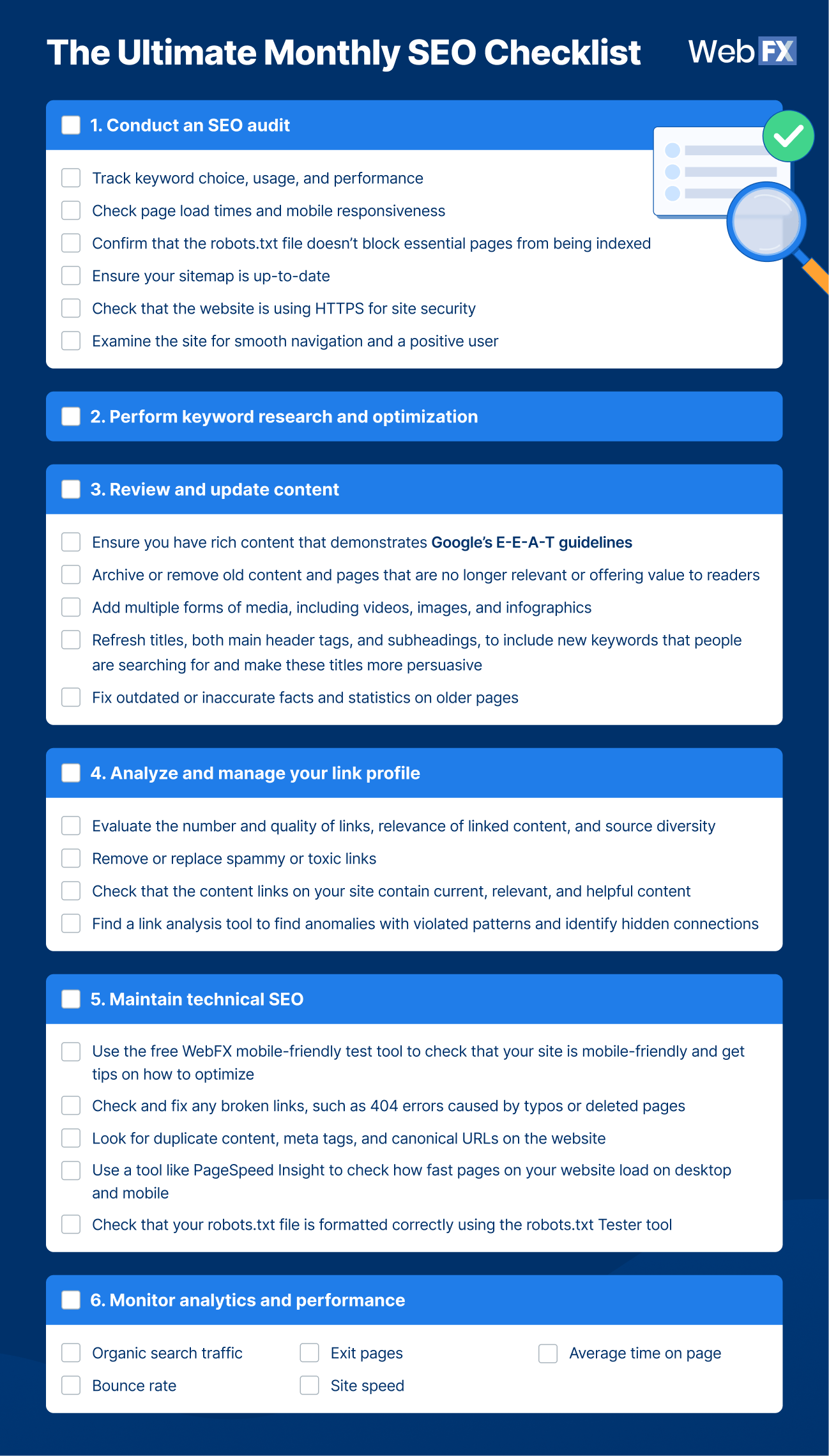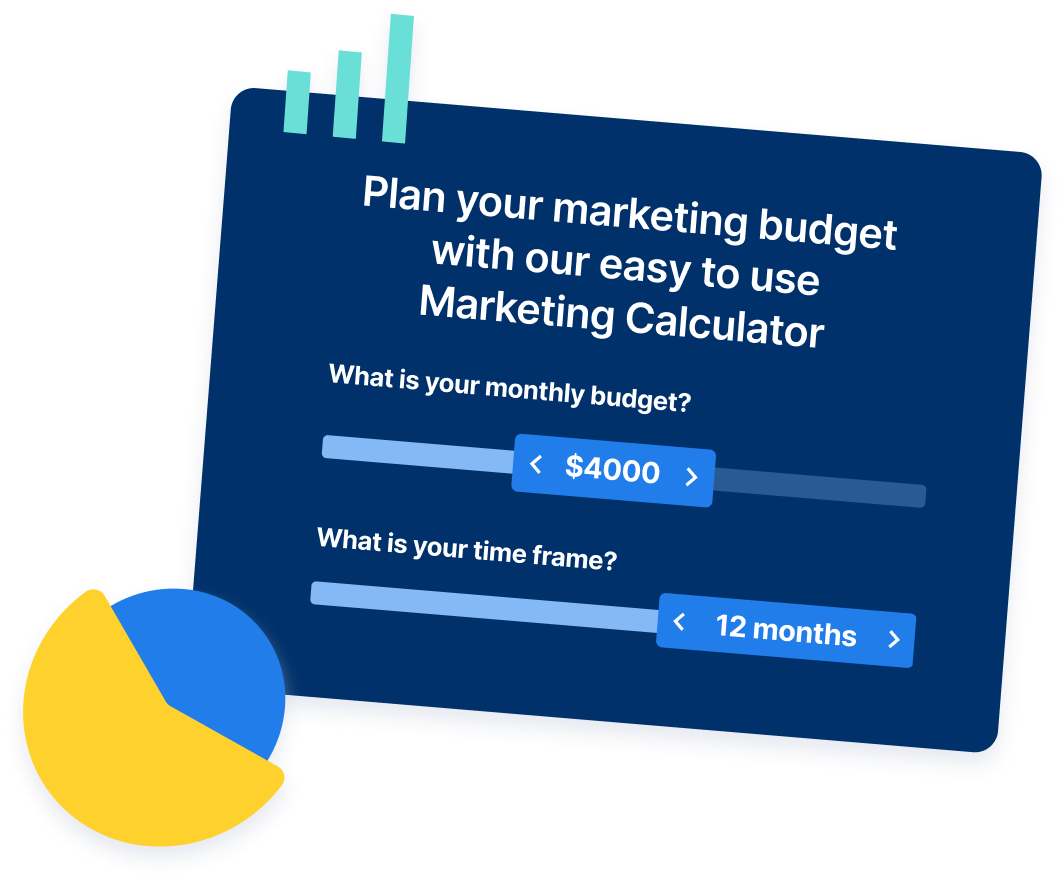-
 Published: Apr 4, 2025
Published: Apr 4, 2025
-
 7 min. read
7 min. read
- Summarize in ChatGPT
-
 Lornah Ngugi
Lornah Ngugi Marketing Writer
Marketing Writer
- Lornah is a marketing writer with over six years of experience and a knack for writing unique and compelling content for a wide variety of topics in diverse industries. She has written over 400 posts for WebFX clients spanning tech, manufacturing, professional services, and other industries. She likes to start her days with a quiet outdoor walk in the park followed by a perfectly brewed cup of black coffee. There’s nothing a chocolate bar can’t fix for Lornah, from a bad mood to writer’s block.
Contrary to popular belief, search engine optimization (SEO) is not a one-off process. Rather, it’s an ongoing strategy that requires regular checks and balances to improve brand visibility, maintain high search rankings, and drive organic traffic.
Monthly SEO tasks are preplanned maintenance tasks you perform on an ongoing monthly basis to keep your site relevant and visible. These help you identify issues with your website so you can make necessary changes to improve functionality.
These ongoing SEO tasks can be divided into the following five categories, which we will dive deeper into below:
- Conduct an SEO audit
- Perform keyword research and optimization
- Review and update content
- Analyze and manage your link profile
- Maintain technical SEO
- Monitor analytics and performance

1. Conduct an SEO audit
An SEO audit refers to the process of analyzing and identifying the factors affecting your site’s ability to rank on search engine results pages (SERPs). Monthly SEO audits help to pinpoint problems with your website that could be impacting performance, staying current, and adapting to changes.
This process involves auditing on-page, off-page, and technical SEO elements that make a site operate at peak performance. Here’s a checklist of monthly SEO auditing tasks:
- Track keyword choice, usage, and performance
- Check page load times and mobile responsiveness
- Ensure your sitemap is up-to-date
- Confirm that the robots.txt file doesn’t block essential pages from being indexed
- Check that the website is using HTTPS for site security
- Examine the site for smooth navigation and a positive user
You can cruise through monthly SEO audits with WebFX’s free SEO Checker to get a thorough assessment of your website and a detailed report covering all the key SEO elements. To get started, simply enter your website URL, your name, and email address to receive a copy of the report.
SEO checker provides data on key metrics to give you:Looking for an all-in-one SEO audit tool? You’ve found it
2. Perform keyword research and optimization
Keyword research is a crucial part of SEO that helps businesses understand your audience’s search intent and tailor your content to them. Conducting monthly keyword research to identify quality keywords and update your content with the new keywords helps to stay relevant and keep your content high ranking.
Through keyword research, you can also identify new content ideas and topics. Start by looking over competitor websites that are ranking well on search engines to identify the keywords they use.
For these websites to rank higher than you, they must use keywords relevant to the search queries. Therefore, naturally incorporating these keywords in your content will result in higher rankings because Google and other search engines will consider your content relevant and high value.
You must also be keen on effective keyword usage on your website. For starters, avoid keyword stuffing and make sure wherever a keyword is used, it makes sense and provides search engines with context. Additionally, be keen on using keywords at different points of a page, including headers, body content, title tags, and meta descriptions.
Keyword reasearch and optimization tips
- Research competitor content for new keywords and topics
- Check your keyword density and usage to avoid and remove keyword stuffing
- Refresh content as needed to make sure you target search intent
3. Review and update content
Other than keywords being outdated, your content can also be behind its time, which means it may no longer be relevant, engaging, or appropriate for your target audience. Once a month, take time to review all the content on your website to ensure it is fresh, evergreen, high-quality, and well-optimized to improve your search rankings.
Generally, content analysis may sound like an abstract concept, but it’s easier when you have clear goals. You can set content analysis and review goals around the following areas:
- Ensuring you have rich content that demonstrates Google’s E-E-A-T (Experience, Expertise, Authoritativeness, and Trustworthiness) guidelines
- Archiving or removing old content and pages that are no longer relevant or offering value to readers
- Adding multiple forms of media, including videos, images, and infographics, to ensure readers are engaged and remain on your pages for longer
- Refreshing titles, both main header tags, and subheadings, to include new keywords that people are searching for and make these titles more persuasive
- Fixing outdated or inaccurate facts and statistics on older pages, which inevitably become outdated at some point
4. Analyze and manage your link profile
A robust link profile enhances your website’s domain authority and search engine rankings. Including a link quality check to your ongoing SEO plan ensures your site remains a valuable resource. A link profile analysis involves:
- Evaluating the number and quality of links, relevance of linked content, and source diversity.
- Removing or replacing spammy or toxic links that may dampen your SEO efforts by making your content outdated or irrelevant.
- Checking that the content links on your site contain current, relevant, and helpful content for readers.
- Finding a link analysis tool to find anomalies with violated patterns and identify hidden connections
SEMrush’s Backlink Analysis and the Google Disavow Tool are reliable link analysis tools you can use to spot harmful links and toxic backlinks. Your link management process should involve changing URLs, removing pages, and directing pages to new destinations.
5. Maintain technical SEO
Among the main goals of monthly SEO updates is ensuring your site remains fast and mobile-accessible to provide a good website experience. It focuses on backend website and server optimization to help crawlers understand your website better, which can lead to better organic search rankings.
Here’s a monthly technical SEO checklist to lead to higher search rankings, more traffic, leads, and revenue for your business:
- Use the free WebFX mobile-friendly test tool to check that your site is mobile-friendly and get tips on how to optimize
- Check and fix any broken links, such as 404 errors caused by typos or deleted pages
- Look for duplicate content, meta tags, and canonical URLs on the website
- Use a tool like PageSpeed Insight to check how fast pages on your website load on desktop and mobile
- Check that your robots.txt file is formatted correctly using the robots.txt Tester tool to ensure it follows Google’s recommendations
6. Monitor analytics and performance
SEO data analytics needs to be part of your monthly SEO maintenance tasks. It involves gathering and analyzing data to understand what parts of your SEO strategy are working and which ones are not.
Analyzing key SEO metrics helps you understand your audience better so you can attract more qualified leads. Your SEO analytics reports need to focus on the following metrics, which drive results for your website:
- Organic search traffic: The goal of SEO is to boost organic search traffic, which means you should analyze this metric keenly. It helps you understand which pages drive traffic to your site and how you can optimize other pages to drive similar results.
- Bounce rate: This metric helps understand how prospects interact with your pages. A good bounce rate may indicate that your content is not relevant, pages load too slowly, and your title tags and meta description are misleading.
- Site speed: Analyzing site speed helps to determine if your audience is getting information quickly. The ideal page load time is three seconds or less, according to 83% of users. Google tends to rank fast-loading sites higher than slower ones.
- Exit pages: These are the last pages most people view before exiting your site. This SEO metric should be analyzed monthly to help you understand how people interact with your site and find ways to optimize the specific pages.
- Average time on page: The amount of time users spend on a page indicates how relevant and informative your pages are. Understanding this metric could help you ensure you engage site visitors for longer and build qualified leads.
Sign up for monthly SEO services by WebFX
SEO can be a complex and tedious process, especially when you don’t have the expertise and experience. You can boost your marketing return on investment (ROI) by outsourcing ongoing SEO to professionals, like WebFX, to implement and maintain a profitable SEO strategy.
At WebFX, we offer monthly SEO packages that are geared to helping you capture more traffic, leads, sales, and revenue. Subscribing to our monthly SEO services gives you access to a dedicated account manager, ongoing SEO audits, first-party data activation, and audit implementation.
With these services, you can streamline your SEO strategy, accelerate your ROI, and grow your bottom line. Request a proposal today for a custom ongoing SEO plan, or call us at 888-601-5359 to discuss your needs with one of our 220+ SEO experts.
-
 Lornah is a marketing writer with over six years of experience and a knack for writing unique and compelling content for a wide variety of topics in diverse industries. She has written over 400 posts for WebFX clients spanning tech, manufacturing, professional services, and other industries. She likes to start her days with a quiet outdoor walk in the park followed by a perfectly brewed cup of black coffee. There’s nothing a chocolate bar can’t fix for Lornah, from a bad mood to writer’s block.
Lornah is a marketing writer with over six years of experience and a knack for writing unique and compelling content for a wide variety of topics in diverse industries. She has written over 400 posts for WebFX clients spanning tech, manufacturing, professional services, and other industries. She likes to start her days with a quiet outdoor walk in the park followed by a perfectly brewed cup of black coffee. There’s nothing a chocolate bar can’t fix for Lornah, from a bad mood to writer’s block. -

WebFX is a full-service marketing agency with 1,100+ client reviews and a 4.9-star rating on Clutch! Find out how our expert team and revenue-accelerating tech can drive results for you! Learn more
Try our free Marketing Calculator
Craft a tailored online marketing strategy! Utilize our free Internet marketing calculator for a custom plan based on your location, reach, timeframe, and budget.
Plan Your Marketing Budget

SEO Success with KOA

Proven Marketing Strategies
Try our free Marketing Calculator
Craft a tailored online marketing strategy! Utilize our free Internet marketing calculator for a custom plan based on your location, reach, timeframe, and budget.
Plan Your Marketing Budget






